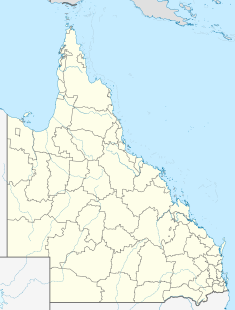Eagle Farm Racecourse and Ascot Railway Station
| Eagle Farm Racecourse and Ascot Railway Station | |
|---|---|

Eagle Farm Racecource, 2013
|
|
| Location | 230 Lancaster Road, Ascot, City of Brisbane, Queensland, Australia |
| Coordinates | 27°25′38″S 153°04′03″E / 27.4271°S 153.0675°ECoordinates: 27°25′38″S 153°04′03″E / 27.4271°S 153.0675°E |
| Built | 1863 onwards |
| Official name: Eagle Farm Racecourse and Ascot Railway Station, Ascot Racecourse, Brisbane Racecourse, Racecourse Railway Station | |
| Type | state heritage (built) |
| Designated | 25 June 2004 |
| Reference no. | 602195 |
| Significant period | 1882-1958 (fabric) 1863-ongoing (social) 1865, 1882, 1885, 1912, 1941-1946 (historical) |
| Significant components | stables, totalisator, bridge - foot/pedestrian, toilet block/earth closet/water closet, residential accommodation - housing, trees/plantings, garden - ornamental/flower, grandstand, bandstand/rotunda, railway siding, wall/s - retaining, greenhouse, refreshment booth, tree groups - avenue of, gate - entrance, tunnel - pedestrian, office/administration building, railway station, signal box/signal cabin/switch house/mechanical points (rail), ticket box/office |
Eagle Farm Racecourse and Ascot Railway station is a heritage-listed pair of racecourse and railway station at 230 Lancaster Road, Ascot, City of Brisbane, Queensland, Australia. It was built from 1863 onwards. The racecourse is also known as Ascot Racecourse and Brisbane Racecourse, and the railway station was known as Racecourse railway station. It was added to the Queensland Heritage Register on 25 June 2004.
The Eagle Farm Racecourse was established in 1863 and continues to operate as one of Queensland's premier racecourses. Additions and extensions include the establishment of the Pinkenba railway line (1882), the Paddock Stand (1889), the St Leger Stand (1913 with extensions in 1938), the Totalisator Building (1913 with extensions in the 1920s and 1950s), the entrance gates (1913), ticket boxes (1914), the Members' Stand (1925) and the John Power Stand (1958), as well as a number of other timber and brick buildings and timber stabling areas. The Ascot railway station opened in September 1882 to bring race-goers to the Eagle Farm Racecourse.
Horse racing was one of the earliest sports practiced in Queensland following the opening of the Moreton Bay district in 1842. Organised by the Moreton Bay Racing Club, the first recorded horse races in Brisbane were held at Coopers Plains on 17 July 1843. A racecourse at New Farm had been established by May 1846, when the first races were held there during that year and operated until the early 1860s.
The establishment of the Eagle Farm Racecourse in 1863 signaled the demise of the course at New Farm. A grant of 320 acres was approved with the site being named the "Brisbane Racecourse". The Deed of Grant for the racecourse land, signed by Governor Bowen on 12 October 1863, stipulated that "the appropriation thereof [was] as a racecourse and for no other purpose whatsoever". It was placed under the trusteeship of Maurice Charles O'Connell MLC, John Frederick McDougall MLC and George Harris MLC, members of the Queensland Turf Club. A grandstand capable of seating 350 people was erected and a saddling paddock was constructed before the first three-day meeting at the Eagle Farm Racecourse took place on 14 August 1865. Attended by about 2000 people, the races took place in a thickly forested area, and race-goers could catch only occasional glimpses of the horses. The first Chairman was Colonel MC O'Connell who served the club in this capacity until 1875. At the time of his appointment, O'Connell was president of the Queensland Legislative Council, a position he held from 1860-1879.
...
Wikipedia

